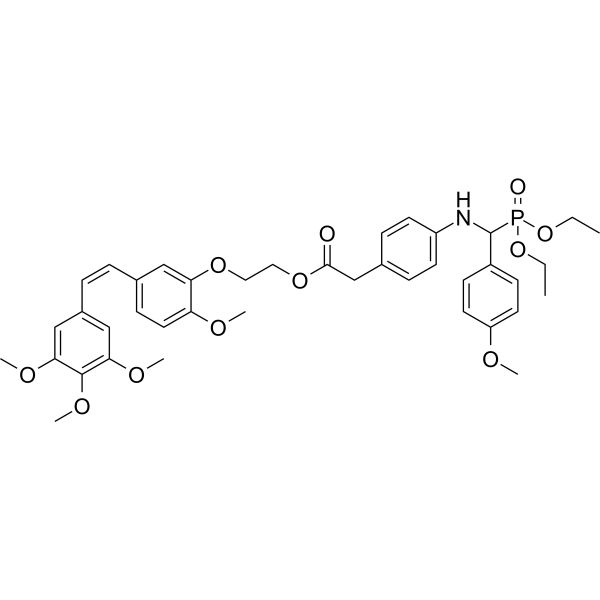| Target |
IC50: 0.36 μM (HepG-2), 0.31 μM (HT29), 0.19 μM (A549), 0.42 μM (MGC-803), 10.45 μM (LO2 cells); 0.32 μM (SK-OV-3), 0.39 μM (SK-OV-3/CDDP), 0.27 μM (MCF-7), 0.25 μM (MCF-7/DOX); 24.95 μM (MMP-2), 31.60 μM (MMP-3), 22.37 μM (MMP-9)[1].
|
| In Vitro |
Tubulin/MMP-IN-2 (Compound 9e) (0.01-20 μM; 24 h) has activity for HepG-2, HT29, A549, MGC-803 and LO2 cells with IC50 values of 0.36 μM, 0.31 μM, 0.19 μM, 0.42 μM and 10.45 μM, respectively[1]. Tubulin/MMP-IN-2 has anti-proliferative activities for SK-OV-3, SK-OV-3/CDDP, MCF-7 and MCF-7/DOX cells with IC50 values of 0.32 μM, 0.39 μM, 0.27 μM and 0.25 μM, respectively[1]. Tubulin/MMP-IN-2 has inhibitory activities against MMP-2, MMP-3 and MMP-9 with IC50 values of 24.95 μM, 31.60 μM and 22.37 μM, respectively[1]. Tubulin/MMP-IN-2 (2.5, 5 Μm; 24 h) strongly inhibits tubulin polymerization, and induced cell apoptosis and cell cycle arrest in G2/M stage, remarkably displayed inhibition of cell migration against A549 cells in vitro[1]. Tubulin/MMP-IN-2 (2.5, 5 Μm; 24 h) can induce apoptosis via mitochondria-dependent apoptosis pathway[1]. Tubulin/MMP-IN-2 (2.5, 5 Μm; 24 h) can also cause ER stress demonstrating as up-regulation express of proteins (CHOP, p-elF2a, and p-PERK)[1]. Cell Cytotoxicity Assay[1] Cell Line: HepG-2, HT-29, A549, MGC-803, SK-OV-3, MCF-7, SK-OV-3/CDDP, MCF-7/DOX and normal liver cells LO2 Concentration: 0.01-20 μM Incubation Time: 72 h Result: Exhibited the most potent activity against various human cancer cells as well as multidrug-resistant tumor cells (A549/CDDP and MCF-7/DOX) and also showed significantly lower cytotoxic activity toward human normal liver cells LO2. Apoptosis Analysis[1] Cell Line: A549 cells Concentration: 2.5, 5 μM Incubation Time: 24 h Result: Significantly induced apoptosis after 24 h. Cell Cycle Analysis[1] Cell Line: A549 cells Concentration: 2.5, 5 μM Incubation Time: 24 h Result: Induced a concentration-dependent G2/M stage arrest of A549 cells. Immunofluorescence[1] Cell Line: A549 cells Concentration: 2.5, 5 μM Incubation Time: 24 h Result: Remarkably induced changes in cell morphology, such as loss of membrane protrusions, disrupted microtubule organization and microtubule depolymerization, respectively. Western Blot Analysis[1] Cell Line: A549 cells Concentration: 2.5, 5 μM Incubation Time: 24 h Result: Increased the accumulation of CHOP, p-eIF2a and p-PERK. Promoted the expression of pro-apoptotic protein (Bax), and regulated down the level of anti-apoptotic protein (Bcl-2). Increased the levels of caspase-3. Lead p53 obviously up-regulated in a concentration-dependent manner. Cell Migration Assay [1] Cell Line: A549 cells Concentration: 2.5, 5 μM Incubation Time: 24 h Result: Significantly reduced cell migration in a dose-dependent manner.
|
| In Vivo |
Tubulin/MMP-IN-2 (15, 30 mg/kg; every two days for three weeks) displays significant in vivo antitumor efficacy in A549 xenograft models without inducing apparent systemic toxicity[1]. Animal Model: BALB/c nude mice[1] Dosage: 15, 30 mg/kg Administration: Every two days for three weeks Result: Exhibited a dose-dependent inhibitory effect on tumor growth. Exhibited no obvious histopathological changes for the main organ tissues (e.g. heart, liver, spleen, lung and kidney).
|
